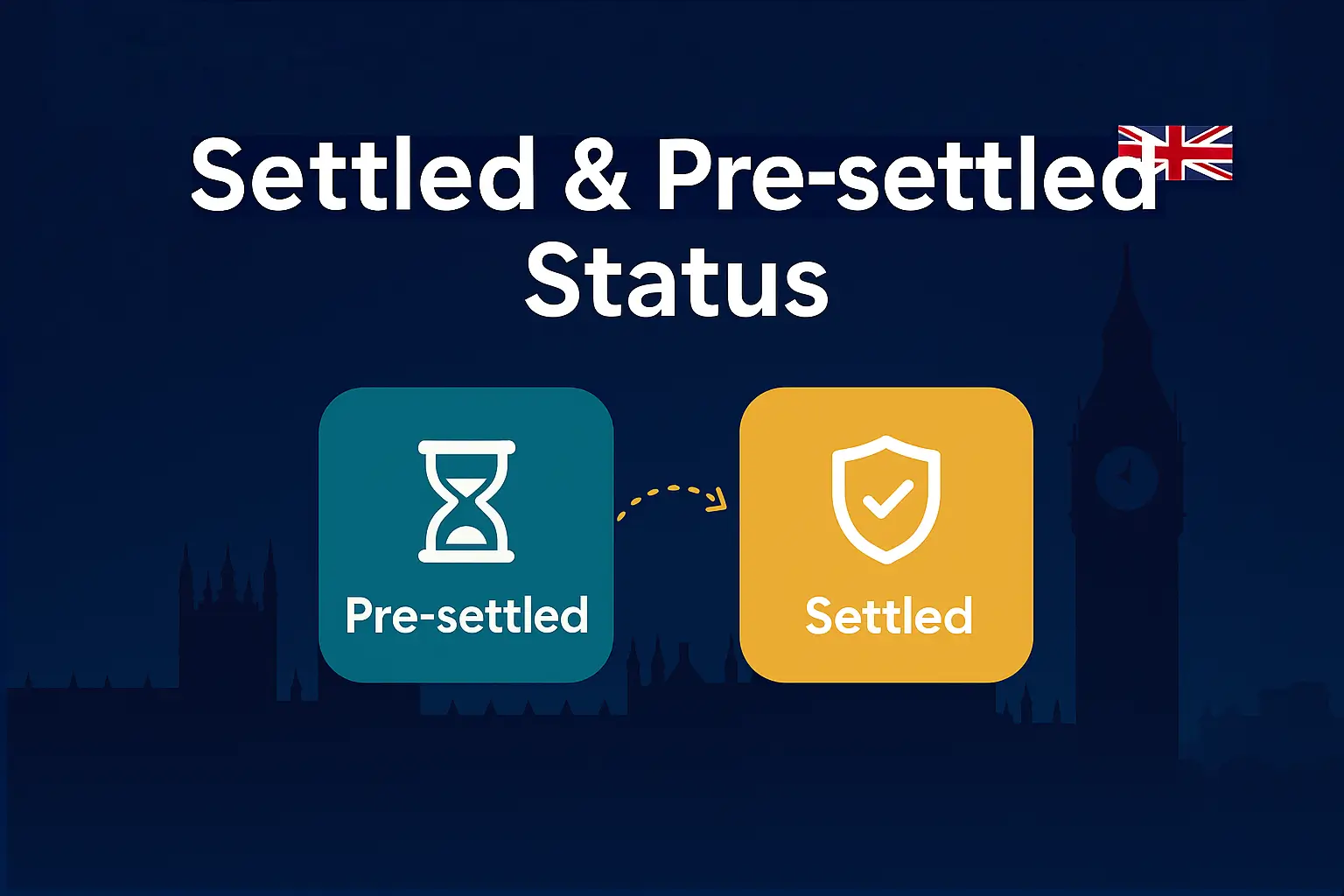This guide explains the differences between settled and pre-settled status, how to prove your residence, and which documents you need.
Having settled or pre-settled status allows you to work, rent, or study in the UK legally.
Disclaimer: This content is for informational purposes only and does not represent legal advice.
Comparison Table: Settled vs Pre-settled
| Feature | Pre-settled | Settled |
|---|---|---|
| Duration | Limited (usually 5 years) | Indefinite |
| Main rights | Work, rent, NHS, study | Work, rent, NHS, study + stability |
| Allowed absences | Up to 6 months in any 12-month period (one exception of up to 12 months for serious reasons) | Must not be absent for more than 5 consecutive years |
| When it expires | After 2 consecutive years outside the UK | After 5 consecutive years outside the UK |
| How to upgrade | After 5 continuous years of residence with evidence | — |
Settled Status
What does “settled status” mean?
Settled status means you have permanent residence in the UK. You can stay indefinitely and have full stability and rights.
Main rights under settled status
- Right to work without restrictions
- Right to rent accommodation
- Access to NHS
- Right to study and apply for Student Finance
- Option to apply for British citizenship (under certain conditions)
Allowed absences & keeping your status
You can be outside the UK for up to 5 consecutive years without losing your status.
Keep proof of residence such as council tax bills, utility statements, or bank statements.
How to prove you have settled status
Use your Share Code (UKVI) generated from the government portal, together with your date of birth and a valid passport or ID card.
Quick examples
- “I have settled status but work abroad for 8 months a year.” → That’s fine, as long as you don’t stay away for 5 consecutive years.
- “I renewed my passport.” → Update your document in your UKVI account.
Pre-settled Status
What does “pre-settled status” mean?
It means you have temporary residence, usually valid for 5 years.
After that period, you can apply for settled status if you meet the residency rules.
Main rights under pre-settled status
- Right to work and study
- Right to rent accommodation
- Access to NHS and Student Finance
- Ability to bring family members (under certain conditions)
Continuous residence & absences
To qualify for settled status later, you must not be absent for more than 6 months in any 12-month period during those 5 years — except for one permitted 12-month absence for serious reasons (e.g., pregnancy, studies, illness).
You may lose pre-settled status if you are outside the UK for more than 2 consecutive years.
Moving from pre-settled to settled
After 5 continuous years of residence (meeting absence rules), you can apply for settled status.
Keep evidence such as contracts, council tax records, and bank statements.
Quick examples
- “I was abroad for 7 months in one year.” → This may break continuity; check if you qualify for the one-time 12-month exception.
- “My ID expired.” → Update your document in your UKVI account.
How to obtain settled or pre-settled status
Background
The EU Settlement Scheme (EUSS) allowed EU citizens and their family members to apply for legal status to stay in the UK.
Most Romanians already hold pre-settled or settled status.
Practical steps
- Search “Get a share code UK” on Google.
- Verify your identity (passport or ID card).
- Upload proof of residence if requested.
- Receive your decision: pre-settled or settled, depending on your history.
Applying for university and need to prove your immigration status?
Get free help — step by step!
How you can lose your status
EU citizens and their family members under the EUSS keep their rights for life unless:
- They are absent from the UK for more than 2 years (pre-settled).
- They are absent for more than 5 years (settled).
⚠️ Note: Those with pre-settled status cannot move to settled status if they exceed 6 months’ absence in any 12-month period (except for one approved case of up to 12 months).
Frequently Asked Questions about Settled and Pre-settled Status
Can I work and study with pre-settled status?
Yes. You have full rights to work and study — just keep your documents up to date.
How do I check my status or generate a Share Code?
Use the official “View and Prove your immigration status” service on the UKVI website, then share your code and date of birth.
What if I’ve been abroad for 7 months in one year?
This may affect your continuity for settled status — check if your situation fits the 12-month exception.
Will I lose my pre-settled status if I’m away for 2+ years?
Yes. Being absent for more than 2 consecutive years results in losing your pre-settled status.
Can I lose settled status if I work abroad?
Only if you stay away from the UK for more than 5 consecutive years.
What evidence helps when applying for settled status?
Council tax bills, utility bills, bank statements, employment contracts, tenancy agreements, and official letters (NHS, HMRC, GP).







